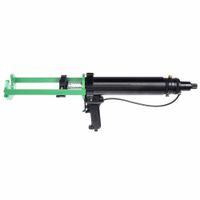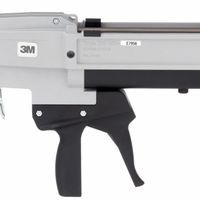Call +(254) 703 030 000 / 751 483 999 / 721 704 777
- Home
- Adhesives Sealants And Tape
- Adhesive Sealant Dispensing Equipment
- Two Part Applicators Nozzles
.....Read More
Frequently Asked Questions
What are two-part applicators used for?
Two-part applicators are specialized tools used to mix and apply two-component materials, which require a chemical reaction between two separate substances to achieve their final properties. These materials often include adhesives, sealants, coatings, and foams. The applicators are designed to ensure precise mixing and dispensing, which is crucial for the performance and effectiveness of the end product.
The two components, typically referred to as Part A and Part B, are stored separately to prevent premature curing or setting. When the applicator is activated, the components are mixed in a specific ratio, often through a static mixer attached to the applicator. This ensures a homogeneous mixture, which is essential for the material to achieve its intended strength, adhesion, or other properties.
Two-part applicators are widely used in various industries, including automotive, aerospace, construction, and electronics. In the automotive industry, they are used for bonding and sealing parts, such as windshields and body panels. In construction, they are used for structural bonding and sealing applications, such as anchoring bolts and filling gaps. In electronics, they are used for potting and encapsulating components to protect them from environmental factors.
The design of two-part applicators can vary, ranging from manual dispensers to pneumatic or battery-operated systems, depending on the volume and precision required. They offer advantages such as reduced waste, improved accuracy, and enhanced control over the application process, making them essential tools for professionals who work with reactive materials.
How do mixing nozzles work with two-part adhesives?
Mixing nozzles for two-part adhesives are designed to combine two separate components, typically a resin and a hardener, into a homogenous mixture for effective bonding. These nozzles are often used with dual-cartridge systems, where each cartridge contains one of the adhesive components.
The process begins when the adhesive is dispensed from the cartridges. The two components are pushed simultaneously into the mixing nozzle, which is attached to the cartridge outlet. Inside the nozzle, a series of static mixing elements are arranged in a helical or spiral pattern. These elements are strategically designed to divide, fold, and recombine the adhesive streams multiple times as they pass through the nozzle.
As the components travel through the mixing elements, they are repeatedly split and recombined, ensuring thorough mixing. The design of the mixing elements creates turbulence and promotes diffusion, which enhances the blending process. The number and configuration of these elements can vary depending on the viscosity and reactivity of the adhesive, as well as the desired mixing quality.
Once the adhesive exits the nozzle, it is a fully mixed, uniform substance ready for application. The mixed adhesive begins to cure as the chemical reaction between the resin and hardener initiates. The nozzle ensures that the mixture is consistent, which is crucial for achieving optimal adhesive performance, including bond strength and durability.
Mixing nozzles are disposable, preventing cross-contamination between uses and ensuring that each application starts with a fresh, uncontaminated mix. This system simplifies the application process, reduces waste, and enhances the reliability of the adhesive bond.
What are the advantages of air-powered two-part applicators over manual ones?
Air-powered two-part applicators offer several advantages over manual ones:
1. **Consistency and Precision**: Air-powered applicators provide consistent pressure and flow, ensuring uniform mixing and dispensing of the two components. This results in a more reliable and precise application, reducing the risk of human error.
2. **Increased Efficiency**: These applicators can dispense materials faster than manual ones, significantly increasing productivity. This is particularly beneficial in high-volume or time-sensitive applications.
3. **Reduced Operator Fatigue**: Manual applicators require significant physical effort, which can lead to operator fatigue, especially during prolonged use. Air-powered applicators minimize physical strain, allowing operators to work longer without discomfort.
4. **Improved Mixing Quality**: The automated mixing process in air-powered applicators ensures a thorough and consistent blend of the two components, enhancing the quality and performance of the final product.
5. **Versatility**: Air-powered applicators can handle a wide range of viscosities and material types, making them suitable for various applications and industries.
6. **Enhanced Control**: Operators have better control over the dispensing process, including the ability to adjust flow rates and pressure settings, allowing for more precise application tailored to specific project requirements.
7. **Reduced Waste**: The precision and control offered by air-powered applicators lead to less material waste, as the exact amount needed can be dispensed accurately.
8. **Safety**: These applicators reduce the risk of repetitive strain injuries associated with manual dispensing and often include safety features that protect operators from exposure to hazardous materials.
9. **Cost-Effectiveness**: Although the initial investment may be higher, the increased efficiency, reduced waste, and improved quality can lead to long-term cost savings.
Overall, air-powered two-part applicators enhance productivity, quality, and safety, making them a superior choice for many industrial and commercial applications.
How do you choose the right nozzle for a two-part adhesive application?
To choose the right nozzle for a two-part adhesive application, consider the following factors:
1. **Adhesive Type and Viscosity**: Different adhesives have varying viscosities. Select a nozzle that can handle the specific viscosity of your adhesive to ensure smooth flow and proper mixing.
2. **Mix Ratio**: Two-part adhesives often require precise mixing ratios. Choose a nozzle designed to accommodate the specific mix ratio of your adhesive to ensure optimal performance.
3. **Mixing Method**: Determine whether static or dynamic mixing is required. Static mixers are suitable for low to medium viscosity adhesives, while dynamic mixers are better for high viscosity or fast-curing adhesives.
4. **Application Method**: Consider how the adhesive will be applied (e.g., bead, spray, or dot). The nozzle shape and size should match the desired application pattern to ensure accuracy and efficiency.
5. **Cure Time**: Fast-curing adhesives may require nozzles that facilitate quick and thorough mixing to prevent premature curing within the nozzle.
6. **Material Compatibility**: Ensure the nozzle material is compatible with the adhesive to prevent degradation or contamination.
7. **Environmental Conditions**: Consider the working environment, such as temperature and humidity, which can affect adhesive flow and curing. Choose a nozzle that performs well under these conditions.
8. **Equipment Compatibility**: Ensure the nozzle is compatible with your dispensing equipment, including cartridge size and connection type.
9. **Cost and Availability**: Balance performance needs with budget constraints. Consider the availability of replacement nozzles to avoid downtime.
10. **Manufacturer Recommendations**: Follow the adhesive manufacturer's guidelines for nozzle selection to ensure optimal performance and warranty compliance.
Can two-part adhesives bond different types of materials?
Yes, two-part adhesives can bond different types of materials. These adhesives consist of a resin and a hardener that, when mixed, undergo a chemical reaction to form a strong, durable bond. They are versatile and can adhere to a wide range of substrates, including metals, plastics, ceramics, glass, wood, and composites. The ability to bond dissimilar materials is due to their chemical composition and the mechanical interlocking that occurs during the curing process.
Two-part adhesives, such as epoxies, polyurethanes, and acrylics, offer high strength and resistance to environmental factors like temperature, moisture, and chemicals. This makes them suitable for applications in industries such as automotive, aerospace, construction, and electronics. The choice of adhesive depends on the specific materials involved, the required bond strength, and the environmental conditions the bond will face.
For optimal results, surface preparation is crucial. This may involve cleaning, roughening, or priming the surfaces to enhance adhesion. The mixing ratio of the resin and hardener must be precise to ensure proper curing and bond strength. Additionally, the curing time and temperature should be controlled according to the manufacturer's specifications.
In summary, two-part adhesives are effective in bonding different types of materials due to their chemical versatility and ability to form strong, durable bonds. Proper surface preparation, mixing, and curing are essential to achieve the desired performance.
What maintenance is required for two-part applicators?
Two-part applicators, often used for dispensing adhesives, sealants, or coatings, require regular maintenance to ensure optimal performance and longevity. Here are the key maintenance steps:
1. **Cleaning**: After each use, clean the applicator thoroughly to prevent material buildup. Disassemble the nozzle and any removable parts, and use appropriate solvents or cleaners recommended by the manufacturer to remove any residual material. Ensure all parts are completely dry before reassembly.
2. **Inspection**: Regularly inspect the applicator for wear and tear. Check for cracks, leaks, or any signs of damage in the nozzle, mixing elements, and seals. Replace any worn or damaged parts immediately to prevent malfunction.
3. **Lubrication**: Some applicators may require lubrication of moving parts to ensure smooth operation. Use the lubricant specified by the manufacturer and apply it to the recommended areas, such as pistons or trigger mechanisms.
4. **Calibration**: Periodically check the calibration of the applicator to ensure accurate mixing ratios. This is crucial for maintaining the integrity of the two-part material being dispensed. Follow the manufacturer's guidelines for recalibration procedures.
5. **Storage**: Store the applicator in a clean, dry environment when not in use. Ensure that it is stored in a way that prevents dust accumulation and protects it from physical damage. If the applicator will not be used for an extended period, consider applying a protective coating to metal parts to prevent corrosion.
6. **Replacement of Consumables**: Regularly replace consumable parts such as mixing nozzles and cartridges. These parts can wear out quickly and affect the performance of the applicator.
7. **Training**: Ensure that all operators are properly trained in the use and maintenance of the applicator. Proper handling and operation can significantly reduce wear and extend the life of the equipment.
By following these maintenance steps, you can ensure that your two-part applicator remains in good working condition, providing reliable and efficient performance.
How do you ensure proper mixing of two-part adhesives with nozzles?
To ensure proper mixing of two-part adhesives using nozzles, follow these steps:
1. **Select the Right Nozzle**: Choose a static mixing nozzle designed for the specific adhesive system. The nozzle should match the adhesive's viscosity and mixing ratio to ensure thorough blending.
2. **Check Cartridge Compatibility**: Ensure the adhesive cartridge is compatible with the mixing nozzle. The cartridge should be designed to fit the nozzle securely to prevent leaks and ensure consistent flow.
3. **Purge the System**: Before attaching the nozzle, dispense a small amount of adhesive from the cartridge to ensure both components are flowing freely and without obstruction.
4. **Attach the Nozzle Securely**: Firmly attach the mixing nozzle to the cartridge. Ensure it is tightly secured to prevent any leakage during dispensing.
5. **Use a Dispensing Gun**: Employ a manual or pneumatic dispensing gun to apply consistent pressure. This ensures a steady flow of adhesive through the nozzle, promoting even mixing.
6. **Monitor the Mixing Process**: Observe the adhesive as it exits the nozzle. It should appear uniform in color and consistency, indicating proper mixing. Any streaks or color variations suggest inadequate mixing.
7. **Test the Mixture**: Dispense a small amount of adhesive onto a test surface. Check for uniformity in color and texture. Allow it to cure and test its mechanical properties to ensure it meets the required standards.
8. **Maintain Nozzle Cleanliness**: After use, clean or replace the nozzle to prevent cured adhesive from blocking the flow in future applications.
9. **Follow Manufacturer Guidelines**: Adhere to the adhesive manufacturer's instructions regarding mixing ratios, working times, and curing conditions to ensure optimal performance.
10. **Regularly Inspect Equipment**: Periodically check the dispensing equipment and nozzles for wear and tear to maintain consistent performance and prevent mixing issues.




